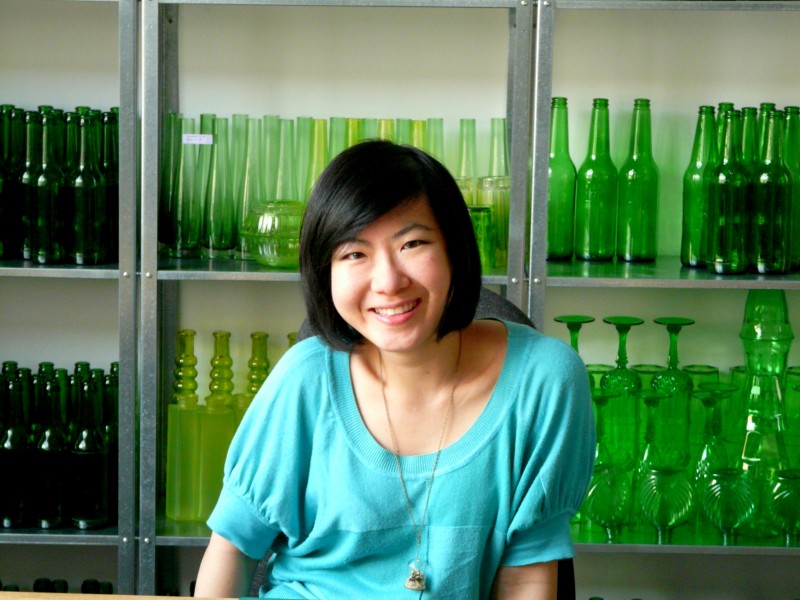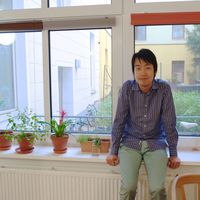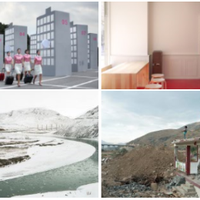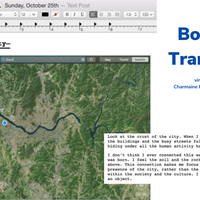Two Singaporean artists in Berlin | Donna Ong | Part II
 [caption id="attachment_36168" align="aligncenter" width="496"]
[caption id="attachment_36168" align="aligncenter" width="496"] Donna Ong in her studio at Künstlerhaus Bethanien, Photo: Katerina Valdivia Bruch[/caption]
Donna Ong in her studio at Künstlerhaus Bethanien, Photo: Katerina Valdivia Bruch[/caption]In 1974, in the mid of the squatting movement in former West Berlin’s Kreuzberg district, the Central Deaconess Institute and Hospital Bethanien was scheduled for demolition. In this environment, a group of artists proposed a space for arts and gave the building a new meaning. Several institutions, including the art centre Künstlerhaus Bethanien, were hosted in the former hospital.
In 2010, the building was renamed as Kunstquartier Bethanien, and Künstlerhaus Bethanien moved to a new location in a former light factory, a few blocks from the initial settlement. Until today, Künstlerhaus Bethanien is one of the reference institutions for international artist in residence programmes. Renowned artists such as Singaporean Ming Wong, who did the programme in 2007, have passed through this place gaining international recognition, as it is a reference venue for a number of curators and art practitioners worldwide.
Donna Ong did her college studies in UK. After this, she studied architecture at Bartlett Centre University College and later visual arts at Goldsmiths College. Song-Ming Ang studied English Literature at NUS (National University of Singapore) and further did a MA in Aural & Visual Cultures at Goldsmiths College. Their experiences travelling back and forth from Europe to Asia, and the international artistic career are part of this interview, but also their experience as resident artists at the prestigious art centre Künstlerhaus Bethanien. In this interview, Song-Ming Ang and Donna Ong share their experiences in Germany’s capital city and how they involve their practice within the context they have been living in.
- See the Part I interview with Song-Ming Ang here: https://culture360.asef.org/magazine/two-singaporean-artists-in-berlin-song-ming-ang-part-i/#sthash.kUt6TVBe.dpuf
Interview with Donna Ong - Part II
[gallery ids="36192,36191,36190,36181,36180,36179,36173,36174,36175,36176,36177,36178,36172,36171"]
KVB: Donna, you are currently resident at Künstlerhaus Bethanien. Which was the reason to apply to the programme and come to Berlin?
DO: I’ve been based in Singapore for the past 8 years and before that I spent about 9 years in England and it just felt like the right time to move to a new place. In Singapore, you can get complacent as an artist. There are not too many - installation artists. I think I know two other people who do installation art as their main practice.
Oftentimes, when people talk about installation artists, they tend to cite me, especially students. A lot of my friends, whom I studied art with, became teachers and they introduced my work to their students. But, as a result, there seemed quite a few students who felt inspired by my work and used me as their reference artist. (laugthers). I felt a constant pressure to innovate and improve, whilst always feeling that others were just biting at my ankles, just one step behind me. I felt the need to change, because if I stayed where I was, the other artists mimicking my work would be more successful with what I was doing (laughters).
Here in Berlin, the situation is very different. Here everyone says: "I do film, sculpture, a bit of drawing and installations" - everyone is an installation artist here! It's good to look at different types of installation art and just be pushed as well in your practice. So, it's great coming here to look around and start asking people questions. It is also good to have critique, which is something you don't get too much in Singapore. You don't get that many curators or people writing about art, and in Berlin there are obviously many people doing this.
KVB: And in this space (the Künstlerhaus Bethanien), there are many people that come around.
DO: Yes, and it is really nice when people look at your work. If you make your work by yourself in a bubble, you don't have any references. So it's good to come here and just have people reflect on what the work means to them, or to see how it works in a different culture.
KVB: What kind of subjects are you developing during your residency year at Bethanien?
DO: I am working on a project I've worked on before, which I started just before I came to the Bethanien. It's based on landscape. Previously, I had been creating work about childhood, imagination and themes of hope. While working with these themes, I created landscapes, but they were not the focus of the work. Recently, I have been thinking about landscape more deeply and am trying to understand what I’ve been doing and making landscape the focus rather than the background of the work. I am posing questions such as what is the meaning of landscape, what does forest mean or what does a cave mean. What are the themes and stories that emerge when you set it within a forest, when you set it within or on a mountain. There are many themes that come out and I have been thinking of using landscape as a starting point and then developing it from there.
KVB: Your works are mostly installations that depict imaginary landscapes with a certain uncanny touch. In an interview with Enoch Cheng from Asia Art Archive, you said that you have a desire to inhabit certain dreams and with this, to escape from reality. Do you still have these ideas in mind when you decide to create an artwork?
DO: Yes, I think so. For me art takes you away from your everyday life to a different place. Some artworks can do that really effectively, and you emerge as a different person – hopefully! And I think that is what I always want to do with my artwork. At that point of time, at that moment, the audience is in a different space, in a different world. Perhaps even having a different experience of time – perhaps you are not moving as fast, you are moving slower, or perhaps sometimes you are moving even faster. And because of that, things seem and feel different. I think that is something I am conscious of striving towards. I want this to happen because I want to create an atmosphere that makes it condusive for the audience to get what I am trying to say. So, it's not just about giving them an experience of a different world or stimulating different senses, but helping them slow down and absorb the themes and stories within the work.
KVB: Your work reminds me about the book Invisible Cities by Italo Calvino, in which there is a fictional conversation between Marco Polo and Kublai Khan. In the book, Marco Polo is telling him the myriad of possibilities of imaginary cities. It is not only about other possible worlds, with different dimensions, characteristics, time or references, but also what travellers might experience during their journeys, regardless where they come from and where they might go next. I had the chance to see your work at the Singapore Art Museum and was particularly attracted by Crystal City and your capability to develop possible worlds from daily use objects.
DO: It's a great compliment for me to be linked to Invisible Cities in your question, as it is one of my favourite books. I thought about what I want my art to be like and I guess the experience that came closest, was the experience I get when reading a book, especially an escapist book. When I was a kid and was troubled, I always escaped to read a book and be transported to a different world. I felt safe there and was always excited to experience that different world within the pages. Of course in reality, I am still stuck in my real world, my problems are still there. However for that short span of time, you are transported somewhere else. Reading a book is such an immersive experience. When I read, I can't hear or see anything else. My parents would call me to come for dinner and I wouldn’t hear them because I was too involved in the book!
I wanted this immersive experience for my own work. I wanted to create another world, but one that was not far away from the audience. I wanted this world to be closeby, that you almost felt you could recreate the same environment in your own house, or you felt that there was a possibility that maybe your neighbour had something like it. I wanted to create a world that almost any person could make.
In my work, the idea of being able to identify the objects within the installation is important to me, as it is the idea that the project is not a total installation. For example, you can recognise that I am trying to recreate a landscape like a cityscape. But, at the same time, you can also see that it is made out of different heights of glassware. So, you as the audience have to put some effort in order to make it work. You have to sustain the belief, use your imagination to make all these disparate things meld into a city. You have to suspend your disbelief and say: "Ok, this is a coral landscape" or "This is a city".
I really like the idea of the audience working and cooperating with me in order to make the piece work. So, I don´t try to do too much, and I use recognisable everyday objects to construct my pieces. It doesn't work perfectly, because I just want the audience to animate it. For a child the box becomes an airplane through his/her imagination and playacting. Kids have to work at it, but in working and committing to play, they start investing in it. And when they invest in something, they are able to get more out of the work and to have it affect them more deeply. For example, in some of the kid's toys today, the dolls can walk, talk and even pee. The kid doesn’t have to do or imagine anything. I feel that makes the child less involved – he or she just watches and the doll does everything. The child doesn't picture him or herself in this imaginary world, because they are not doing anything. I think that's partly why I use everyday objects in these landscapes and why the illusion is not perfect. Often when you go into the room, the installation is in the middle of the room and there is a space where you can walk around. So, you are still aware that is an object and that there is still a space where you can choose to enter or to stay out of it. There is a commitment you give when you walk or step into the installation, and more when you participate in it. Only then, the installation comes alive and you start to experience it.
KVB: Do you consider that there is a difference between the concept of landscape in Europe and the one from Asia?
DO: I think the biggest difference is maybe the idea of the view. I am not sure whether in modern Asia we have so many views. Going to a mountain to look at a view - I think that could be a Western concept. The way you go to a particular place to look at something which is deemed beautiful. I think in Asia we are often surrounded by the landscape. It surrounds you and you are in it. It's not too much that you stand apart from it and admire it, but you are within it, working in it. Yes, you can admire it, but you are within it. You are part of it. There is never a point when you are separated from that landscape itself.
And, I think in Singapore there are very few views. I mean, if you need a view you have to pay 20 Euros and then you can go up to the rooftop of Marina Bay Sands and have a look at the view. There is not so many views that are readily available and most of them are high-rised, bird viewpoint views. A lot of the spaces I am working with feature views that are very close up - right next to it, you come across it, you come upon it. In Singapore in particular, because there is not many views, everything is very detailed and close-up. We tend to look at things close-up, we tend to close things out, spaces are quite small, the flats and things like that. So, we look at things closer. If we think of exhibitions, the size is different or the perspective is different, lower or a different kind of scale. Usually, it is more a micro view, from far away looking down, close-up. As a result, the detail becomes more important. Everything is very tight. I will say just one last thing about landscape from the Asian and Western viewpoints: I think in Asia it is more about things jumbled up together and being tied together, whereas in Western culture, things are more separate and distinct. One looks at things in isolation, separated from others.
Click here to see Donna Ong's website: http://www.donnaong.com/





